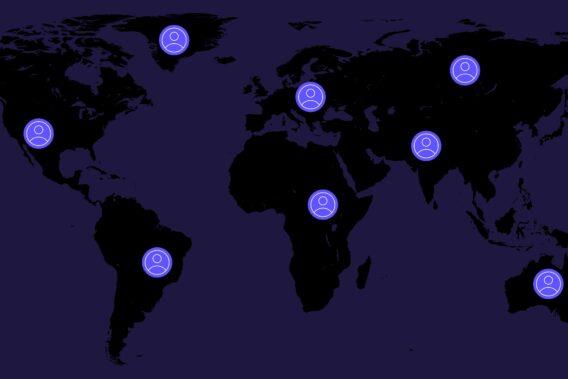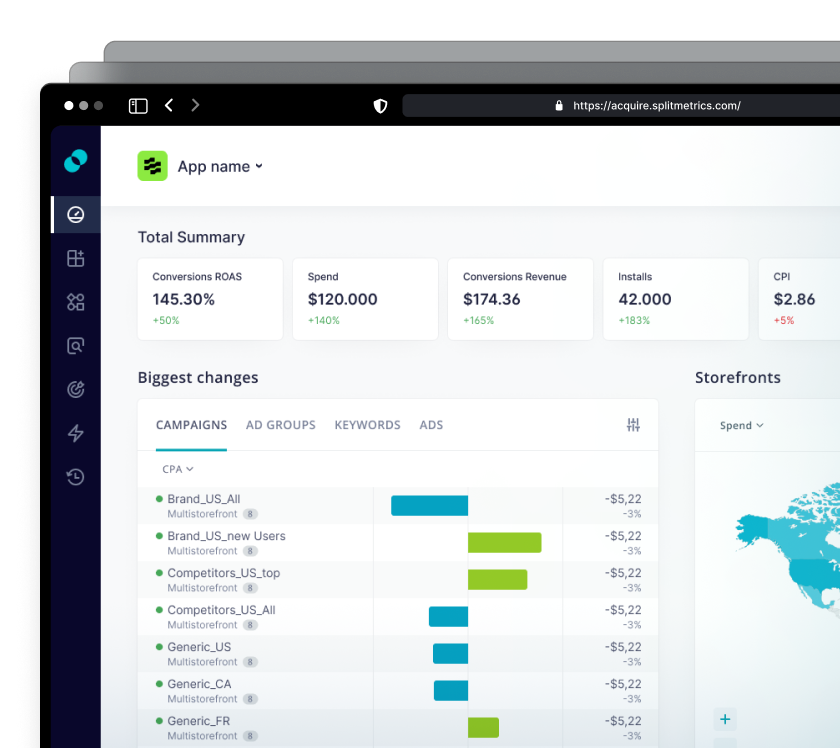How to Find Your Target Audience for Mobile Apps
If you have a product to sell or a service to offer, you have to know who your target audience is. Who buys your product? Who benefits from your service? It’s pointless to go on building a brand without first knowing who you’re building it for.

A target audience is a group of people that your product or service is intended for. But, that’s only the first step in mobile app user acquisition. If you know what your target audience looks like, what’s next? The next step in mobile app user acquisition is reaching your target audience. This is how you get your target audience to be aware that your app even exists.
In this article, we will focus on how to find and reach the target audience for mobile apps.
For apps, a well-defined target audience benefits both the technical and business factors. Think about user-centric UX/UI designs or targeted marketing campaigns. They both involve knowing who the target audience is.
The Importance of Having a Target Audience
Before we dive into the topic of how to find a target audience, we need to address the importance of having a target audience.
First, get it out of your head that your mobile app is meant for everyone. You will never be able to please everyone. It’s simply impossible. Groups of people have different needs and interests. Groups of people are living in different stages of life.
We are using the word “groups of people” on purpose. As we said, it’s impossible to have an app for everyone. But, it also doesn’t make sense to have an app for one person. You want more than one person to be using your app. It has to be intended for a group of people. That group of people needs to share similar demographics, interests and problems. When you’ve figured out who that group of people is, it is easier for you to start planning ahead: you know who to design for, what features they would enjoy, and where to reach them in marketing campaigns.
A truly effective user-centric approach comes from knowing who your target audience is.
Without a target audience, you’re left with no guidelines for design, development and marketing.
You should spend your limited time and resources on people who will actually install, enjoy and continue using your app.
People whose interests don’t match the purpose of your app will probably end up uninstalling your app. Uninstalls hurt your ASO strategy, causing your app to be ranked lower in app store searches. An uninstall tells the app store search algorithm that people don’t like your app and for that reason, it must be bad.
People who aren’t interested in your app will not only uninstall it but they will also not recommend it to anyone. So your efforts in getting them to install your app become a total waste. Your target audience is much more likely to continue using your app and recommend it to their friends. This is why reaching your target audience and not just anyone or everyone is important and efficient.
Think Like Your Audience
Finding your target audience is not about you, it’s about your audience.
Start by asking yourself these questions:
- What problem is your app solving?
- Who is your app helping?
- Who would want to use your app?
- How would a person use your app?
The answers to these questions are the first steps of identifying your target audience. The next step is identifying your target audience’s demographics and then building user personas according to these demographics.
Dive Deeper:
7 Ways to Leverage Social Media to Grow Your Mobile Apps
What is App Localization?
How to reach your Target Audience (App Users) who search for information
App Store Search
App Store Optimization
65% of people find apps through app store search. To get ahead of your competitors, your app marketing strategy has to include app store optimization (ASO). When your ASO is lacking, your app will too. It won’t show up in the app store search results. People won’t know that your app exists. You can rank better by using the right keywords in your app name and description. Remember to use keywords that your target audience would use when they’re searching for a new app.
Another factor is visuals. Your app preview screenshots have to be attractive. The best screenshots highlight the major features of an app that a target user would like. There are a few other factors affecting your position in the app store search. We can’t fit it all in here. However, if you want to learn more about ASO then head over to App Radar’s ASO Academy.
Apple Search Ads and Google app campaigns
Apple Ads and Google app campaigns are advertising options for their respective app stores. By bidding on relevant keywords and constructing targeted ad audience groups, you can exponentially increase your app’s exposure in the Apple App Store and Google Play store. These app store ads show up above other search results. That means, when somebody searches for a keyword that your bid won out for, your app will be the first one that they see.

Web Search
Your app should show up in a regular web search as well. When you need information on something, what do you do? Most likely, you turn to a search engine, perhaps Google.
People are constantly searching for information on the internet. The difference lies in what they search for. Travel lovers look for travel tips, hotel reviews, and destination itineraries. Foodies look for restaurant reviews, new recipes, and nutritional facts. Stay-at-home moms look for toilet training advice or nursery rhymes.

Source: Google
There are 2 ways to reach your target audience through search engines. The first is targeted search engine ads and the second is content marketing.
Targeted Search Engine Ads
One option is to run targeted search engine ads. You already have the information to do this if you’ve done research on your target audience. The same variables that you used to find your target audience can be used to reach your target audience. Look at their demographics. Where are they located? What languages do they speak? Look at their interests. What do they like? What kind of things do they search for? Apply these demographics and interests to your search engine ad campaigns and your website will show up in your target audience’s search results.
Content Marketing
Content marketing is the process of gaining brand awareness and conversions through the use of content. What is content? We’re talking about blog posts, infographics, videos and more.
Create content that matches your target audience’s interests. Destination itineraries for travel lovers. Recipes for foodies. Toilet training advice for stay-at-home moms. Not only does the subject of the content matter, but where you post your content matters too. Consider which medium is going to be better received by your target audience. If you’re targeting people ages 18-24, a video might the better choice. But don’t forget that quantity never makes up for quality. The content your producing needs to provide value to your target audience. Entertain or educate them first. Then go for conversion with a call to action. No one likes a straight-up sales pitch.
When making content, remember that quantity never makes up for quality.
Content marketing also goes hand in hand with search engine optimization (SEO). By producing good quality content on a certain topic regularly, you increase your chances that a search engine will label you as an expert in that field. Your website will then show up more frequently in the search results for that topic. To rank higher in search engine results, your content has to include relevant keywords. Another way to improve your search engine ranking is to generate healthy backlinks. You can accomplish this by collaborating with other bloggers and companies in related fields.
How to reach your Target Audience (App Users) who browse
Social Media
Social media is a powerful tool. Let’s find out how you can use it to your advantage.
Social media allows you to be exactly where your target audience is and to build up a brand image outside of your website and app store listing page.
First, consider if your target audience is even on social media and if so which platform. For example, 41% of Facebook users are 65+ while 64% of Instagram users are 18-34. You’re targeting 18-34 year-olds? You better be using Instagram.
Here are some tips on how to use some of the most popular social media platforms to reach your target audience:
Like and comment on your target audience’s photos. Post captivating photos and videos with a related caption that includes a call to action. Use Instastories for a behind-the-scenes look into your company. You can also try using targeted ads on both the feed and in stories.
Share original and curated content that matches your target audience’s interests. Communicate with your target audience through Facebook messenger. Another option is to run targeted ads and Facebook messenger ads. Use a Facebook messenger chatbot to answer questions about your mobile app.
Open conversations with your target audience. Answer questions, comments, and complaints about your mobile app. Stay up to date with current events and trends. Retweet those and include your opinion. Twitter also allows you to run ads.
Youtube
Publish videos that are entertaining or educational or both 🙂 You can choose to show a behind-the-scenes look into your company. Explain how to use your mobile app. Highlight the major features of your mobile app. Remember to include a call to action in the description box below the video.
Publish photos and videos to give an inside look into your company. Share infographics that spark conversations. Share new product or feature updates. Connect with other professionals in the field for collaborations. Establish your company as an expert in your niche by posting an article on Linkedin.
There are many ways to take advantage of social media. The examples above are just a few. Don’t be afraid to experiment with different platforms and mediums to discover what works best for your brand.
As I mentioned above, social media is also the perfect place to build up your mobile app brand’s image.
A good example of this is Bumble’s Instagram page. Their page provides value to their users through entertainment. It also posts funny memes, quotes, and conversations that are all about online dating. And they also have a cohesive aesthetic, a specific font, and a color scheme. Followers instantly recognize the posts as being from Bumble.

Source: Bumble on Instagram
Another example of this is Code with Chris’s Youtube page. He provides value through education. Chris offers free coding lessons with his Youtube videos. Then in his video descriptions, he always places call to action, directing viewers to his Coding Fundamentals Course and to his other social media pages. Notice that his Youtube page is also cohesive in aesthetic. For each series, the thumbnail design stays the same, so that viewers know right away which lesson series they’re watching.

Source: Code with Chris on Youtube

Source: Code with Chris on Youtube

Source: Code with Chris on Youtube
And the last point for social media. You can use social media to give your target audience a sneak peek of what your mobile app does. This way people get to know what your app is about and its major features before they install it. The sneak peek is especially useful if your app is not available for free. People want to know what they’re getting before they pay for it, even if that’s only $1 or $2.
Influencers
People trust and listen to influencers. Influencers can help you reach your target audience and grow your app. Influencer marketing is a relatively new marketing strategy that has not yet been fully adopted by all industries and mobile apps are definitely one of them. You are already one step ahead of other app businesses when you decide to dedicate some resources toward influencer marketing.
Influencer marketing is all about finding the influencers that have influence in the niche that you are targeting. People trust influencers who are knowledgeable about the things they’re interested in. People want to try products and services recommended to them by influencers they trust. Travel influencers for travel lovers. Foodie influencers for foodie lovers. Mommy influencers for stay-at-home moms.

Source: WeAreTheDads on Youtube

Source: WeAreTheDads on Youtube
There are a few things to consider when choosing appropriate influencers:
- They are active on the social media platform your target audience is using
- They create content related to the interests your target audience has
- They have follower demographics similar to your target audience’s demographics
Getting these influencers to recommend your app is an effective way to get more people in your target audience to know about and install your app.
People want to try products and services recommended to them by influencers they trust.
Word of Mouth Marketing
People recommend products they like to their friends. People trust not only influencers but also their friends and family. Word-of-mouth marketing or referrals is a great way to reach your target audience. People tend to tell their friends and family about the products and services that they enjoy. This applies to mobile apps as well, in particular to social apps.
To ensure that your current users are spreading the word about your mobile app, make sure you have a built-in referral program. You can decide on whether or not to reward the person being referred, but you should always reward the person who is doing the referral. The motivation needs to be big enough that your current users feel totally compelled to share your mobile app with their friends and family. You could offer extra bonus points, unlock further features or offer similar goodies as a reward.

Source: Robinhood App
Use notifications to remind users to invite their friends. Offer them something special if they bring more than one user in return. Referrals instantly reach your target audience. Current users who enjoy using your app know at least one person in their friend circle would also enjoy using your app. Friends usually share interests and demographics. When people invite their friends into your app, they’re reaching your target audience for you.
Social apps greatly benefit from word-of-mouth marketing. The purpose of a social app is to be social. Friends want to be on platforms their friends are on. No one likes to feel like they’re missing out. FOMO is real. A referral program gives a person even more reason to invite their friends. And when all their friends are using a social app, everyone will want to stay on that platform.

Identifying Target Audience Demographics
A target audience is much more than phrases such as, “university students” or “North America”. Your target audience needs to be a specified group of people that share certain demographics and interests. Use your answers to the questions above to help you identify these demographics.
A target audience includes the following demographics:
1. Age
Keep the age range wide but not too wide. For example, 20-60 is way too large. A 50-year-old is unlikely to have the same interests as a 13-year-old. There are also usability differences: A 60-year-old probably has a hard time reading small font that a 20-year-old can easily see. Ideally, your age range should stay within a single generation. A better example would be 13-18 or 20-35.
2. Gender
Men and women are equal but not the same. What does this mean? Imagine you have a shopping app. You’ll need to appeal to men and women differently. Research shows that men shop because they need to. It’s a task that they have to check off their to-do list. Women shop because they love to. They want to browse and learn about brands. Make sure you are aware of those differences when creating your target audience.
3. Location
The world is a large place. Your app won’t be available to everyone. It can’t be. Some people don’t even have a smartphone. The location can be a region, country, state, county or even city if you are offering regional solutions. It all depends on the purpose of your app.
4. Language
Again, the world is a large place. There are many different languages used in today’s world. Language changes the way the brain thinks. English speakers read left to right. Arabic speakers read right to left. Make sure you are aware of such cultural differences. In addition, the language you choose for your user personas is also the language(s) your app is localized into.
5. Education
Education covers several levels. This could be a primary school, high school, university, and continuing education. What is the education level of the person? This affects their reading comprehension and vocabulary levels, which influences the way you’re going to talk to them within your app and in your marketing campaigns. Usually, a younger audience prefers a casual communication style, whereas the generation around 50+ tends to use more formal language.
6. Occupation
Purchasing power is an important factor here. If you offer paid app or in-app purchases, you’ll want to be targeting people who have the purchasing power. Occupation also tells you how busy the person is. Do they work part-time or full-time? Will they have time for your app? Will they need your app for professional purposes? All this information is valuable when thinking about your target audience.
7. Marital Status
Single. Married. Divorce. Widowed. Different marital statuses affect the way a person makes decisions. A single person gets to focus more on themselves while a married person has to focus also on their partner. Those differences are also reflected in the type of apps a single or a married person uses.
8. Familial Status
Familial status gives you the same insights marital status does. It tells you if this person responsible for only themselves or for others as well. 13-year-olds for example, are neither responsible for themselves nor others. Someone is responsible for them and many of their decisions, including buying in-app purchases.
9. Interests
List any interests here that don’t fall into the other demographics. Does your user enjoy going to the gym or traveling? Do they play fantasy football or real football? These interests will humanize a user persona making them more real and easier to relate to. This will also make it easier for you to understand which social media channels your users are likely to be using.
10. Devices
A relevant one for the mobile industry. Does the person have an iPhone or an Android? Or maybe neither. They operate on an iWatch or a tablet. Your app better be available and it better work well on the devices your target users use. You have to be where your users are.
These are surface-level demographics. At times these can be enough to define your target audience. But we should dig deeper. Psychological demographics also affect who will want to use your app and how they will use it.
Psychological demographics for a user persona are:
1. Personality
You’ve got your overachievers, underachievers, extroverts, introverts, sensitives, insensitive, intellectuals, and emotionals. People embody all sorts of personalities. Personalities reveal how someone reacts to certain situations, whether that’s in real life or in the digital realm.
2. Values
What is important to your target users? Do they care about making money, and saving the environment? Do they value family values or are they more entrepreneurial? Values show you what matters to a person.
3. Behavior
Is your target user an excessively organized person or are they an excessively messy person? They could also be a messy-organized person type of person. You can see how each one of the behavior profiles would, for example, use a daily planner app in a different way and would need different features. Being aware of user behavior allows you to adapt your app’s design and functionalities to better appeal to your users.
4. Habits
Habits lay close to behavior and can be synonymous with lifestyle. How is your user living their life? A person who frequents the gym may enjoy a fitness-tracking app. A person who frequents their local coffee shop would benefit from a loyalty rewards app. If you’re targeting luxury-loving people then your app should be designed to feel luxurious.
Target Audience Example
Once you’ve identified these demographics, put them together to build your target audience. You should always create a target audience visual that you refer to. There are a few ways to do this, and one of them is to build actual user persona profiles.
User personas are individual profiles that visualize and humanize your target audience. User personas remind you of your target audience when you’re designing, developing, and marketing your app. The design should appeal to the personas. The features should feel seamless to the personas. The marketing strategies should target real people similar to the created personas.
Create 5 or more user persona profiles for 1 target audience.
Let’s create a user persona and target audience for a travel app meant to help solo travelers connect while abroad.
Look at how the user persona fits nicely into the target audience. The target audience gives you an overview of the group of people you’re targeting. The user persona humanizes the target audience, giving you an actual picture of a person who would use your app.


All of this information can be found by searching the internet. It is also extremely useful to conduct your own interviews and surveys. Talk to people and get their opinion on your app and its functionalities. Record the feedback and make note of which kind of person said what. Real-life examples can inspire well-thought-out user personas and target audiences.
From here you can more easily pinpoint possible challenges, pain points, wants, and goals that your target audience has. If you already have users, then gather this information from them by asking for feedback through surveys, focus groups, or other means of communication.
Dive Deeper:
4 Ways to Get More Organic App Installs
How to Improve App Retention Rate with Organic Installs
5 Biggest Mobile App Marketing Mistakes to Avoid
Summary: How to find your Target Audience
A well-defined target audience is important because it’s the foundation on which you build your design, development and marketing strategies.
Finding a target audience involves analyzing the purpose of your app and what problem it’s solving. Then dive into exactly what kind of person would want to use your app. Holding a clear picture of your target audience allows you to make a user-centric design and features. As for marketing, you’ll know where to reach your target audience. Based on the information you’ve gathered, you can find out what social platforms they use, what topics they search for on the internet and what publications they may read or shows they may watch. Target audience is a major factor in finding and acquiring the right users for your app.

Latest Posts


